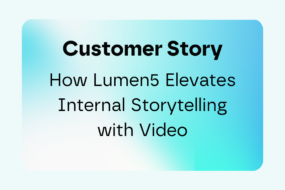
Perspective from Michael Cheng, CEO of Lumen5
Bootstrapping played (and still plays) a huge success in our story. The story of Lumen5 started in 2017 when my co-founders, Chris, Nigel, and I decided to build our next big thing. At the time, video was the talk of the town. Smartphone ownership and cheapening data plans created the perfect storm for widespread video consumption. During that time, Zuckerberg even stated in an earnings call that Facebook would commit to a company-wide push to become “video first.”
A simple question popped into our heads: If people love watching videos and all these platforms support video content, how will content creators produce all these videos to meet the demand? We have selfie cameras and quirky filters in the consumer world, but the business world was still stuck in the 2000s, where you pay an agency thousands of dollars to produce a video with Adobe software.
We could change that.
Our idea was simple. If video is the new language of the web, then we would build a video creator so easy to use that it becomes a standard office tool. Lumen5 would do for video what PowerPoint did for presentations. And as they say, the rest was history.
We saw a recession and lived through it. We felt the direct hits of a pandemic and were fortunate to pull through. Fast forward to 2022, we’re now a 50-person company serving over a million users worldwide. Our platform is used by everyone from your neighbourhood real estate agent to Fortune 500s like Salesforce, Cisco, and Siemens.
Based on our size and scale, it might look as though we raised a round or two to get here, but the reality is that our cap table is the same as the day we started Lumen5. It’s not as though we failed to fundraise, and we never even made a deliberate decision not to fundraise either. We were too busy working on other things, and it just never happened.
We love talking to customers and we love solving their problems. As we solved their concerns over the years, they wanted our solutions, and kept wanting more of our solutions.
And cash flow never became a problem. We earned enough money to grow, and we just kept doing our thing: continually helping our customers adapt to the demand of video marketing while maintaining low costs.
As a recession is nigh and after five years of bootstrapping, I finally feel ready to offer my retrospective insights as to how we may have benefited and continue to benefit from walking the path less traveled.
Bootstrapping builds a customer-first mentality.
Businesses have their hierarchy of needs. Cash is oxygen for every company, and when you run out of cash, the end is nigh. Our survival depends entirely on whether our customers pay and continue to pay us as a bootstrapped company. This dynamic made it natural for us to embrace a customer-first mentality where we would drop everything in pursuit of solving customer problems. You may have heard the saying, “what you focus on grows,” and this is precisely what we saw.
Through the pandemic when our customers’ budgets shrank and/or were drastically cut, we pivoted as their needs evolved, and became an impactful solution – not just for creative teams, but company-wide. We empowered companies to revamp their own internal communications with video, but also encouraged others to digitally transform and adopt a video first approach.
Customers and investors are two very different groups of stakeholders. When the interests align, it’s smooth sailing. But that’s not always the case. By having a single stakeholder, the customer, we could carve out our path with laser focus.
Bootstrapping creates a culture of capital efficiency.
Financing status is a common question we get during our interviews. There’s no right or wrong, but some people get excited about big budgets, and some people get excited about building things on a shoestring budget. However, we have always been capital efficient.
Unbeknownst to us at the time, our bootstrapping strategy would act as a filter for our unique culture fit as Lumen5 became an alternative for those team members who wanted to experience a non-venture-backed environment. This culture became a crucial part of our DNA, a culture of frugality where the value of capital efficiency is well respected.
And as we continue to experience growth, it is important that we stay true to ourselves. We continue to invest in new endeavours like enterprise marketing and creative services, while offsetting costs with government funding.
Bootstrapping encourages unconventional thinking.
When you have lots of money, you can afford to do things “the right way.” When you’re lacking resources, you have to think outside the box. It’s the classic story of the Wright brothers and the flying machine. ✈️ Cash is critical when scaling up tried and true operations, but there’s much value in creativity and unconventional thinking when it comes to innovation.
Rather than jumping straight into a big event sponsorship strategy, what if we could grab a speaker slot for free exposure? Rather than investing in an extensive ad campaign, what if we could build virality directly into the product? Over the years, this approach of creative problem solving became second nature to us: Thinking outside of the box and then around and through the box.
And this mindset has trickled down to our customers as well. As we enter a recession, most customers are looking to offset the costs of creative agencies and take back the control of their own video creation. To some, we are the solution enabling them to produce the same amount of content but under such extreme conditions: less resources, higher demand, and wider variety of videos to create. And to others, we are forging a new path towards increased creativity and the decentralization of video creation.
Bootstrapping ensures relentless focus.
It’s not uncommon for a company with capital to pursue many ideas, resulting in resources being spread too thin, causing mediocrity across all ideas pursued. Kind of a “jack of all trades, master of none” situation.
Bootstrapping puts you in the opposite scenario. We often have to pick just one thing to pursue with finite resources. We understand the need of innovation, especially during a recession, significantly increases. At times where it is the most stressful for our customers, we are able to step up and provide additional value: offering a more stable product that can solve our customers’ most critical problems.
When we do something, it’s all hands on deck, and we rally the entire team to make it happen. We still test things and run experiments, but it’s full steam ahead once we commit. As the saying goes, “less is more.” ( 🎶 Just like Charmain Ultra brand, for sure!)
Bootstrapping results in long-term sustainability.
To keep growing a bootstrapped company, you need healthy unit economics. Being profitable and cash flow positive makes the business more resilient to changing market conditions – we can accelerate when the time is right, or slow down and save up cash if we need to. There’s more time to plan and assess when we’re not racing against a countdown clock fuelled by inflating burn rates.
Being cashflow positive safeguards a company against the all-too-common scenario of startups crashing and burning under the weight of their own hyper-growth. Or when an economic downturn is around the corner, we are able to continue our business activity full steam ahead without additional pressures or worries. Thinking of terms like: “crash and burn” or “recession” and reframing them as “impactful things that your business will need to react to”, can guide you through what preparations are needed and what will need to be done to survive.
There’s this idea that bootstrapping can be incredibly stressful, but I’ve actually found the opposite. One of the hardest things about being an early-stage CEO is balancing fundraising and building the company simultaneously. It all goes back to focus.
Forgoing fundraising has given me more time to talk to customers, build the team, shape the culture, design the product, and the list goes on. These are the activities that founders are often most excited about, and doing what you love is one of the best ways to prevent burnout in the long run.
What the future holds
Many aspiring founders assume that fundraising is necessary, but I’ve learned that there are many solutions to a problem, many paths to a destination, and fundraising is just one potential path for building a business. And although this was my path, my path is not the one and only true path. I hope these insights here can help you make an informed decision as to what’s best for building your own company.
Does this mean we’ll never fundraise? Not necessarily. Fundraising offers its advantages, which I’m sure you can read all about elsewhere. There may come a time when it makes total sense for us to pursue financing, and I’ll be excited for a new adventure when that time comes.






